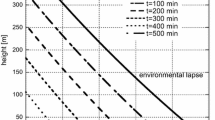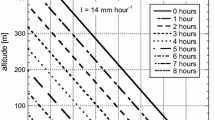Abstract
We suggest a one-dimensional model of precipitation scavenging of soluble gaseous pollutants by non-evaporating and evaporating droplets that is valid for arbitrary initial vertical distribution of soluble trace gases in the atmosphere. It is shown that for low gradients of soluble trace gases in the atmosphere, scavenging of gaseous pollutants is governed by a linear wave equation that describes propagation of a wave in one direction. The derived equation is solved by the method of characteristics. Scavenging coefficient and the rates of precipitation scavenging are calculated for wet removal of sulfur dioxide (SO2) and ammonia (NH3) using measured initial distributions of trace gases. It is shown that scavenging coefficient for arbitrary initial vertical distribution of soluble trace gases in the atmosphere is non-stationary and height-dependent. In case of exponential initial distribution of soluble trace gases in the atmosphere, scavenging coefficient for non-evaporating droplets in the region between the ground and the position of a scavenging front is a product of rainfall rate, solubility parameter, and the growth constant in the formula for the initial profile of a soluble trace gas in the atmosphere. This expression yields the same estimate of scavenging coefficient for sulfur dioxide scavenging by rain as field estimates presented in McMahon and Denison (1979). It is demonstrated that the smaller the slope of the concentration profile the higher the value of a scavenging coefficient.







Similar content being viewed by others
Abbreviations
- a :
-
Raindrop radius, cm
- c :
-
Total concentration of soluble trace gas in gaseous and liquid phases, mole l−1
- c (G) :
-
Concentration of soluble trace gas in gaseous phase, mole l−1
- c (G)c :
-
Concentration of soluble gas at cloud bottom, mole l−1
- c (G)gr :
-
Concentration of soluble gas at the ground, mole l−1
- c (L) :
-
Concentration of dissolved gas in droplet, mole l−1
- d :
-
Raindrop diameter, m
- D G :
-
Coefficient of diffusion in a gaseous phase, cm2 s−1
- H A :
-
Henry’s law constant, mole l−1 atm−1
- k 1 :
-
Growth constant, cm−1
- k a :
-
Thermal conductivity of air, kcal s−1 cm−1 K−1
- K v :
-
Evaporation coefficient, cm2 s−1
- L :
-
Distance between ground and cloud bottom, cm
- L v :
-
Latent heat of evaporation, kcal g−1
- m = H A R g T :
-
Dimensionless Henry’s law coefficient
- R :
-
Rainfall rate, cm s−1
- R g :
-
Universal gas constant, atm l mole−1 K−1
- q c :
-
Mass flux density of dissolved gas transferred by rain droplets, mole cm−2 s−1
- Sh = β d/D G :
-
Sherwood number
- t :
-
Time, s
- u :
-
Terminal velocity of droplet, cm s−1
- U :
-
“wash-down” front velocity, cm s−1
- U 0 :
-
“wash-down” front velocity for non-evaporating droplets, cm s−1
- x (G) :
-
Mole fraction of a soluble trace gas in gaseous phase
- z :
-
Vertical coordinate, cm
- β :
-
Coefficient of mass transfer, cm s−1
- ϕ L :
-
Volume fraction of droplets in air
- τ ch :
-
Characteristic time of concentration change in gaseous phase, s
- τ D :
-
Characteristic time of diffusion, s
- Λ:
-
Scavenging coefficient, s−1
- 0:
-
Initial value
- c :
-
Value at cloud bottom
- gr:
-
Value at ground
- G :
-
Gaseous phase
- L :
-
Liquid phase
- v :
-
Vapor
References
Asman WAH (1995) Parameterization of below-cloud scavenging of highly soluble gases under convective conditions. Atmos Environ 29:1359–1368
Baklanov A, Elperin T, Fominykh A, Krasovitov B (2013) Cell model of in-cloud scavenging of highly soluble gases. J Atmos Sol Terr Phys 97:135–142
Banzhaf S, Schaap M, Kerschbaumer A, Reimer E, Stern R, van der Swaluw E, Builtjes P (2012) Implementation and evaluation of pH-dependent cloud chemistry and wet deposition in the chemical transport model REM-Calgrid. Atmos Environ 49:378–390
Beard KV, Pruppacher HR (1971) A wind tunnel investigation of the rate of evaporation of small water drops falling at terminal velocity in air. J Atmos Sci 28:1455–1464
Brenn G (2005) Concentration fields in evaporating droplets. Int J Heat Mass Transf 48:395–402
Chamberlain AC (1991) Radioactive aerosols. Cambridge University Press, Cambridge
Curtius J (2006) Nucleation of atmospheric aerosol particles. C R Phys 7:1027–1045
Duhanyan N, Roustan Y (2011) Below-cloud scavenging by rain of atmospheric gases and particulates. Atmos Environ 45:7201–7217
Elperin T, Fominykh A, Krasovitov B (2007) Evaporation and condensation of large droplets in the presence of inert admixtures containing soluble gas. J Atmos Sci 64:983–995
Elperin T, Fominykh A, Krasovitov B (2008) Scavenging of soluble gases by evaporating and growing cloud droplets in the presence of aqueous-phase dissociation reaction. Atmos Environ 42:3076–3086
Elperin T, Fominykh A, Krasovitov B (2009) Effect of altitude concentration gradient of soluble gaseous pollutants on their scavenging by falling rain droplets. J Atmos Sci 66:2349–2358
Elperin T, Fominykh A, Krasovitov B (2010) Scavenging of soluble trace gases by falling rain droplets in inhomogeneous atmosphere. Atmos Environ 44:2133–2139
Elperin T, Fominykh A, Krasovitov B, Vikhansky A (2011) Effect of rain scavenging on altitudinal distribution of soluble gaseous pollutants in the atmosphere. Atmos Environ 45:2427–2433
Elperin T, Fominykh A, Krasovitov B, Lushnikov A (2013) Isothermal absorption of soluble gases by atmospheric nanoaerosols. Phys Rev E 87:012807 (1–8)
Flato GM (2011) Earth system models: an overview. Wiley Interdiscip Rev Clim Chang 2:783–800
Georgii HW (1978) Large scale spatial and temporal distribution of sulfur compounds. Atmos Environ 12:681–690
Georgii HW, Müller WJ (1974) On the distribution of ammonia in the middle and lower troposphere. Tellus 26:180–184
Gong W, Stroud C, Zhang L (2011) Cloud processing of gases and aerosols in air quality modeling. Atmosphere 2:567–616
Gravenhorst G, Janssen-Schmidt Th, Ehhalt DH, Röth EP (1978) The influence of clouds and rain on the vertical distribution of sulfur dioxide in one-dimensional steady-state model. Atmos Environ 12:691–698
Gusev IG, Krutitskii PA, Sazhin SS, Elwardany AE (2012) New solutions to the species diffusion equation inside droplets in the presence of the moving boundary. Int J Heat Mass Transf 55:2014–2021
Hales JM (1972) Fundamentals of the theory of gas scavenging by rain. Atmos Environ 6:635–659
Hales JM (2002) Wet removal of pollutants from Gaussian plumes: basic linear equations and computational approaches. J Appl Meteorol 41:905–918
Hales JM, Dana MT, Wolf MA (1973) A linear model for predicting the washout of pollutant gases from industrial plumes. AIChE J 19:292–297
Hannemann AU, Mitra SK, Pruppacher HR (1995) On the scavenging of gaseous nitrogen-compounds by large and small rain drops. 1. A wind-tunnel and theoretical study of the uptake and desorption of NH3 in the presence of CO2. J Atmos Chem 21:293–307
Heese B, Wiegner M (2008) Vertical aerosol profiles from Raman polarization lidar observations during the dry season AMMA field campaign. J Geophys Res 113:D00C11. doi:10.1029/2007JD009487
Heusel-Waltrop A, Diehl K, Mitra SK, Pruppacher HR (2003) A laboratory and theoretical study on the uptake of SO2 gas by large and small water drops containing heavy metal ions. J Atmos Chem 44:211–223
Inselsbacher E, Wanek W, Ripka K, Hackl E, Sessitsch A, Strauss J, Zechmeister-Boltenstern S (2011) Greenhouse gas fluxes respond to different N fertilizer types due to altered plant-soil-microbe interactions. Plant Soil 343:17–35
Jost D (1974) Aerological studies on the atmospheric sulfur-budget. Tellus 26:206–213
Karamchandani P, Ray AK, Das N (1984) Absorption of gases in growing droplets. Chem Eng Commun 30:67–81
Levine JS, Augustsson TR, Hoell JM (1980) The vertical distribution of tropospheric ammonia. Geophys Res Lett 78:7812–7821
Makhonko KP (1967) Simplified theoretical motion of contaminant removal by precipitation from the atmosphere. Tellus 19:467–476
McMahon TA, Denison PJ (1979) Empirical atmospheric deposition parameters—survey Atmos. Environ 13:571–585
Pinchover Y, Rubinstein J (2005) An introduction to partial differential equations. Cambridge University Press, Cambridge
Pruppacher HR, Klett JD (1997) Microphysics of Clouds and Precipitation. Kluwer Academic Publishers, Dordrecht
Seinfeld JH, Pandis SN (2006) Atmospheric Chemistry and Physics. From Air Pollution to Climate Change, 2nd edn. Wiley, New York
Slinn WGN (1974) The redistribution of gas plume caused by reversible washout. Atmos Environ 8:233–239
Walcek CJ, Pruppacher HR (1984a) On the scavenging of SO2, by cloud and raindrops: I. A theoretical study of SO2, absorption and desorption for water drops in air. J Atmos Chem 1:269–289
Walcek CJ, Pruppacher HR (1984b) On the scavenging of SO2 by cloud and raindrops. III. A theoretical study of SO2 washout by rain falling through a pollution plume. J Atmos Chem 1:307–324
Walter EG (1984) Visibility and air pollution. In: atmospheric science and power production, Chapter 20, Oak Ridge, Tennessee, pp 810–826
Zhang L, Vet R, Michelangeli DV (2006) Numerical investigation of gas scavenging by weak precipitation. J Atmos Chem 54:203–231
Zheng W, Luna R, Steinberg LJ (2003) Numerical simulation of rain scavenging on large release of water-soluble gases. J Environ Eng ASCE 129:59–67
Acknowledgments
This study was performed in the framework of COST ES1004 “European Framework for Online Integrated Air Quality and Meteorology Modeling”.
Author information
Authors and Affiliations
Corresponding author
Additional information
Responsible editor: S. Trini Castelli.
Rights and permissions
About this article
Cite this article
Elperin, T., Fominykh, A. & Krasovitov, B. Rain scavenging of soluble gases by non-evaporating and evaporating droplets from inhomogeneous atmosphere. Meteorol Atmos Phys 122, 215–226 (2013). https://doi.org/10.1007/s00703-013-0283-3
Received:
Accepted:
Published:
Issue Date:
DOI: https://doi.org/10.1007/s00703-013-0283-3




